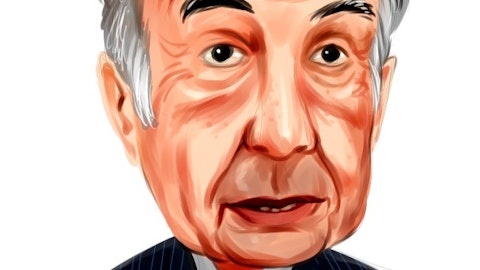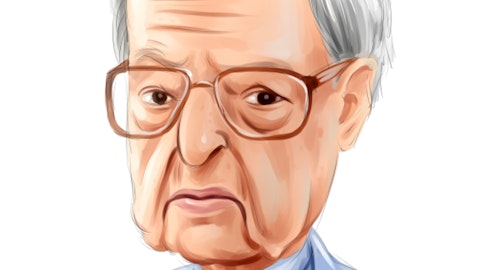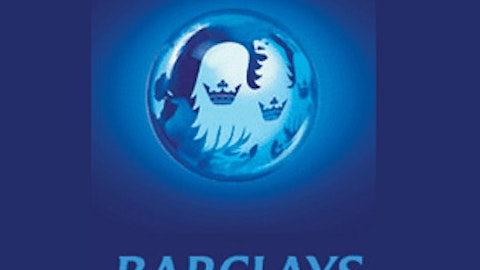JPMorgan Chase & Co. (NYSE:JPM) has rallied from its lows after the London Whale incident, and is now up 18% so far in 2012, but is still short of its high for the year above $46. In the bank’s 10-Q for the third quarter of the year, total net revenue was up 6% from the same period in 2011 and rose 13% on a q/q basis (though the second quarter may have suffered from London Whale losses; JPMorgan Chase’s third quarter had lower net revenue than Q1). Earnings have been even better: net income for the quarter was higher than in any of the four previous quarters, and up 34% from a year earlier. Book value also crawled upward, and as more time passes we think that we don’t need to worry as much about a catastrophic fall in the prices of the bank’s assets.
With the stock’s price hesitating to match the growth of its business, JPMorgan Chase & Co. now trades at 9 times trailing earnings and 8 times consensus earnings for 2013. The banking industry as a whole carries fairly low multiples as the market worries about a weak European and global economy as well as the potential for more regulation, but certainly on an absolute basis that is low enough to be worth considering. The bank’s P/B ratio is 0.8, so it still offers a considerable discount to the book value of its assets- again, something that we like to see as value investors. The dividend yield of 2.8% is not extremely high, but it’s higher than at many other American banks and certainly welcome.
Lansdowne Partners, a large European hedge fund managed by Sir Paul Ruddock and former Harvard Management employee Steve Heinz, is a fan of JPMorgan Chase & Co. At 18 million shares, it was the largest position by market value in the fund’s 13F portfolio for the second quarter of 2012 (find more of Lansdowne Partners’ favorite stocks). John Griffin’s Blue Ridge Capital- Griffin had previously been legendary investor Julian Robertson’s right-hand man at Tiger Management- reported a position of 6.1 million shares at the end of June (see more stocks that this Tiger Cub liked).
JPMorgan Chase’s peers include Citigroup Inc. (NYSE:C), Bank of America Corp (NYSE:BAC), Wells Fargo & Company (NYSE:WFC), and Barclays PLC (NYSE:BCS)– other “big banks” with only Barclays posting a market capitalization under $100 billion. We’d been bullish on Bank of America earlier this year, but we think that trade has played itself out with the stock up 24% in the last three months and now at 10 times forward earnings estimates. It still trades at only half of its book value, but doesn’t seem to be as capable as JPMorgan Chase at generating income. Read about why Bank of America is not cheap anymore. Citi is another stock we’d liked, though it too has been up recently and it may be time for investors to sell. Its forward P/E is 8, and its P/B is 0.6- not much different from JPMorgan Chase, and we think that the latter merits a premium to its peer. With Citi’s revenue and earnings down last quarter versus a year ago, JPMorgan Chase looks like a better buy.
Wells Fargo, the “safe bank,” is a tougher call: we do think that it should in turn have a price premium relative to JPMorgan Chase, but it trades at 1.2 times book value and at a slightly higher forward earnings multiple. The two banks’ recent growth rates have been about in line as well. There’s really not much more to say than that JPMorgan Chase probably has more upside, but also more downside. Barclays is facing a good deal of uncertainty due to its culpability in the LIBOR scandal, but possibly poor sentiment from investors as well. Its P/B of 0.5 and forward P/E of 6 are the lowest of this peer group, but investors should examine the company more closely to see what mix of those two explanations is responsible for the quantitatively low pricing.
We wouldn’t feel quite as safe owning JPMorgan Chase as we would Wells Fargo, but think that it offers a slightly better value particularly on a book basis. An investor could easily justify picking either of these two stocks based on their individual preferences and the current makeup of their portfolio.






